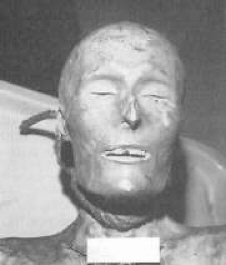Stranger Than Fiction: The Bandit That Wouldn’t Give Up
It was a typical afternoon on December 7, 1976 in Hollywood, California. At a nearby television studio a production crew was preparing the set to film an episode of the hugely popular TV series, “The Six Million-Dollar Man.” This particular scene was set to take place at an amusement park. The crew worked to set up a fun house scene arranging props. Among the props was a fake mummy hanging in the background. Dissatisfied with the position of the mummy, the director told the set designer to move it. When the set designer went to move the mummy, its arm came off. He looked carefully at the arm and began to examine it. Realizing there was a real human bone sticking out of the gauze, the horrified man dropped the arm. This “fake” mummy was actually a real mummified human corpse.
The medical examiner arrived on the scene shortly afterward and questioned the actors and crew. After determining where the mummy came from, he took it to the morgue for examination. Police officers were dispatched to the home of the man who sold the mummy to the TV studio.
When police interviewed the man who once owned the mummified corpse, he told them a remarkable story. As it turned out, the mummy was an outlaw from the old west. His name was Elmer McCurdy.
In 1911, McCurdy was a 35-year-old outlaw who had never amounted to much. He was unintelligent and prone to drink and spent much of his life drifting from job to job, town-to-town, and petty crime to petty crime. He had joined an outlaw gang in hopes of pulling off the one big job that would ensure his financial security. McCurdy was confident he and the two outlaws he laughingly called a gang could pull off that job. In October 1911, McCurdy and the gang learned of a train that was purportedly carrying more than $1,000. On October 4, the gang mounted their horses and struck with lightning fast precision riding alongside the train. Then, at an opportune time, they leapt from their horses onto the train as it slowly chugged along its path near Coffeyville, Kansas.
Masked and armed with pistols, they forced the engineer to stop the train. At gunpoint, he was ordered to the baggage car where he was ordered to open the safe. As it turned out, the outlaws had robbed the wrong train. The train with the large cash deposit had already gone through several hours earlier. McCurdy found only $46 in the safe. The outlaws made off with the meager amount of cash and a case of whiskey before heading toward the Oklahoma wilderness.
For the next two days the outlaws camped and drank themselves into a stupor to celebrate their success. Later that day, they rode to a nearby ranch where the drunken bandits hid out in the hayloft of a barn where they all laid down to sleep. Later that night a three-man posse slowly made its way to the ranch. The rancher’s son tipped them off that the outlaws were in the barn. As they approached the barn, McCurdy immediately started firing on the posse who all scurried for cover. A gun battle raged for nearly an hour. Finally, during a lull of the shooting, two of the outlaws surrendered. McCurdy however, refused to surrender.
The battle resumed and soon McCurdy stopped firing and silence fell over the barn. A bullet to the chest had ended his criminal career. But, this was not the end of Elmer McCurdy. It was a whole new beginning of a show business career that would make many aspiring actors somewhat envious for its longevity. McGurdy began a career that would last 65 years.
McCurdy’s corpse was taken to Pawhuska, Oklahoma, but no one claimed the body. The undertaker embalmed him with arsenic, dressed him in a black suit and put his body in a small coffin. He had done such a thorough job of embalming McCurdy that he looked like he was sleeping. He then propped McCurdy up in a corner in a back room and charged five cents admission to see his mummified body. He billed him as “The Bandit Who Wouldn’t Give Up.”
Patrons came from miles around to view the preserved body. The patrons would slip a nickel into Elmer’s open mouth. After the patrons left the undertaker would retrieve the nickels. Soon, the undertaker was making more money off McCurdy than funerals. In the coming four years he was approached dozens of times by carnival and circus owners who offered to buy the body but he never considered selling his newfound moneymaking enterprise.
Then in 1915, two men came to the undertaker’s funeral home with legal papers. They claimed they were the brothers of McCurdy and had a court order giving them legal right to reclaim their brother’s remains. With heavy heart the undertaker released the body to the two men. Months later he discovered the papers were phony and these two men were not his brothers but unscrupulous carnival owners. By then, they were long gone and there was little chance of recovering the body.
Elmer McCurdy now began a career that would take him all across the country. His body was displayed at circuses, sideshows and carnivals in most of the nation. He was later displayed at Coney Island and Chicago, where he had a lengthy engagement, and the Museum of Crime in Los Angeles where patrons were reminded that crime doesn’t pay.
In the late 1950s, Elmer’s body was showing signs of decay and wear. Most of his hair had fallen out and his skin was drying giving his body an emaciated appearance. The carnival owners wrapped his body in gauze and sold him to a fun house in Long Beach. There it hung for nearly two decades. People walking through the fun house were unaware that one of the props that were intended to frighten them was really a human corpse.
The fun house went out of business in the mid-1970s. The props of the fun house were sold to a T.V. production company. No one mentioned to the new owners that the mummy was a real human corpse. They thought it was simply a dummy made of wood. By the time the truth had been discovered, McCurdy had appeared in dozens of films and T.V. shows where no one was the wiser. He had made more money in death than he ever dreamed of making in life.
Elmer McCurdy was finally laid to rest in April, 1977, at the Summit View Cemetery in Guthrie, Oklahoma where his grave has become a minor tourist attraction.
Michael Williams is the author of a book entitled “Stranger than Fiction: The Lincoln Curse.” The book is a collection of 50 strange and unusual but true stories. The stories will leave the reader convinced that perhaps Mark Twain was right when he said “truth is stranger than fiction.”
The book is 187 pages in a softbound edition with numerous photos. The book can be purchased from amazon.com for $19.95 plus shipping and handling or you can save shipping cost and save $2 on the purchase price by ordering a signed copy directly from the author. Send $17.95 to P.O. Box 6421 Sevierville, TN. 37864.
The book is available in Kindle on Amazon.com for $3.99. For more information visit the website www.strangerthanfictionnews.com.














